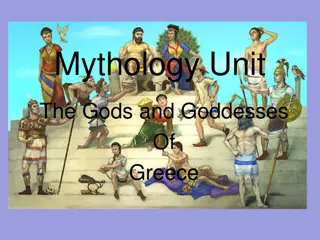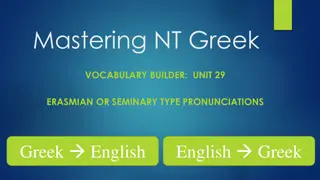Exploring Greek Mythology's Influence on Language and Culture
Dive into the fascinating world of Greek mythology and discover how ancient tales have shaped language and culture through iconic figures like Hercules, Atlas, and Midas. Explore the origins of myth-based phrases and delve into the timeless lessons and values embedded in these oral traditions.
Download Presentation

Please find below an Image/Link to download the presentation.
The content on the website is provided AS IS for your information and personal use only. It may not be sold, licensed, or shared on other websites without obtaining consent from the author. Download presentation by click this link. If you encounter any issues during the download, it is possible that the publisher has removed the file from their server.
E N D
Presentation Transcript
Tales from Around the World Tales from Around the World ORAL TRADITION Power Point by Mrs. Paris-Powell
Learning Target I can identify, describe and analyze 4 genres of oral traditions.
Greek Myths Have Influenced Our Language Mythology s influence is evident in our language. It is hard to imagine reading or writing without drawing upon myth-oriented adjectives or idioms. For instance what it means to have a/an Achilles heel Midas touch
ATLAS: A mythical giant who supported the heavens on his shoulders. (The book of maps known as an atlas is named after a legendary African king, sometimes thought to be descended from the Atlas of Greek myth.) HERCULES: Also known as Heracles, the greatest hero of Greece. (A particularly great exertion is said to be a Herculean effort.) LABYRINTH: A dangerous maze built for King Minos. Sacrificial victims were sent into the Labyrinth from which it was almost impossible to escape. At the center was the monstrous Minotaur. (The English words labyrinth and labyrinthine may derive from certain double-headed axes, archaeological examples of which have been found on the Greek island of Crete, site of the kingdom of mythological King Minos and the Labyrinth.)
PAN: Shepherd god, son of Hermes, with legs and horns of a goat. (Pan was considered to be the cause of the sudden fear that sometimes comes for no reason, especially in lonely places. That s why it s called panic . ) PROCRUSTES: Man who offered his one-size-fits-all bed to passing travelers, adjusting his guests to the bed by stretching or chopping them as appropriate. (A recent article in The New York Times refers to art historians who try to force the famous painter Pablo Picasso into the Procrustean bed of theories. ) SISYPHUS: Sinner condemned to roll a rock uphill for eternity. (A Sisyphean task.) TANTALUS: A king allowed to partake of the nectar of the gods. He abused this privilege by stealing the divine beverage to share with his human friends. For this sin he was condemned to the Underworld, where he stood in fresh water that receded whenever he tried to drink andunder a tree filled with ripe fruit always just beyond reach. (tantalize) TITANS: An ancient race of giants who were overcome by Zeus in a struggle that shook the world. (titanic) MIDAS: A king who had the power to change all he touched to gold. This blessing became a curse. (The Midas touch.)
ORAL TRADITION MYTHS Attempt to answer basic questions Considered truthful by their originators Keep the past alive Teach lessons about human nature Reveal values of the society Folk Tales Told for entertainment PERSONIFICATION ALLEGORY Keep the past alive Teach lessons about human nature Reveal values of the society
ORAL TRADITION Fables Short tales with a moral Animals for character Keep the past alive Teach lessons about human nature Reveal values of the society Oral History Based on real events Considered fact by the teller Passes along information Keep the past alive Teach lessons about human nature Reveal values of the society
Greek Myth Theseus and Minotaur
Fable Fable The Ant and the Grasshopper
Historical Fiction and Oral History A Crown of Wild Olive
Folk Tale Brother Coyote and Brother Cricket
4. GOOD VS EVIL ALL ORAL TRADITIONS!! 1. Keep the past alive 2. Teach lessons about human nature 3. Reveal values of the society HERO
Anticipatory Set What is a hero? Who is a hero in your life? List 3 or more qualities that makes that person a hero to you.
Please Do Now What 3 things do their plots have in common? List 5 types or more of oral tradition texts What do their characters have in common?
Please Do Now List 5 types or more of oral tradition texts Myths Folk Tales Fables Oral History Fairy Tale Legends What 3 things do their plots have in common? Keep past alive, teach a moral, shows values of that time What do their characters have in common? Hero vs Villain
Brother Coyote and Brother Cricket Anticipatory Set Cricket Coyote Habitat Food Prey or Predator 3 facts 1. 2. 3. 4. 1. Habitat 2. Food 3. Prey or Predator 4. 3 facts
What I Learned Coyote Cricket Deserts, grassland, foothills Any small animal- mice, other rodents, fish, bird ominivore Predator Features dog-like, many Native American traditions, strong sense of smell avoid and hunt, can take down a horse-15lbs, 4ft length, 25 inches tall, Walk on tippy toes, fur color based on habitat Under rocks, logs in meadows Prey Feed on grass and sometimes other insects Eat other crickets, jaws that draw human blood, ears on their legs, eat blue jelly calcium and eat lizards, more than 900 species, can tell the temp of area, females can lay up to 200 eggs, short life spand, only males make the sounds
BROTHER What is the denotation of brother? a boy or man who has one or both of the same parents as you What are the connotations of brother? a member of the same ethnic group, a member of the same religious group, same country, social order, job-police firemen, armed forces
After You Read 1. How does this folk tale or folk lore keep the past alive? 2. What is the moral or lesson of the story? 3. What did you learn about the values of that time period? Are they the same today? 4. Which animal allegorically was good and evil? Why do you think the author chose that animal to symbolize good and evil?























